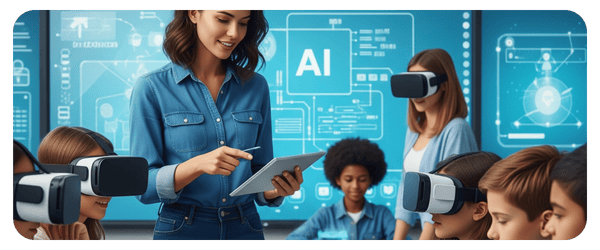The AI Advantage: Why Microschools Are the Best Place to Personalize Learning
Microschools + AI = personalized learning that works. Agile, student-centered, and data-driven—this is where the future of education is already happening.

In most traditional classrooms, change is slow. Curriculum updates take years to implement. Differentiation - while often discussed - is rarely achieved at scale. Teachers are expected to meet the needs of dozens of learners at once, often without adequate tools or time.
Everyone agrees that students learn differently, but the system still treats them the same. Instruction is paced for the average, assessments are standardized, and personalization is often limited to optional worksheets or extra help after school.
This model wasn’t built to adapt. It was built to manage.
What AI Brings to the Table
Artificial intelligence has the potential to break that mold. AI can analyze how students interact with content, identify strengths and weaknesses, and dynamically adjust instruction to fit individual needs.
In practice, that means a student struggling with multi-step word problems doesn’t get buried in frustration… they get targeted support that addresses their specific misunderstanding.
Meanwhile, another student who already understands the material can move ahead without waiting for the rest of the class to catch up.
The potential is measurable. A 2024 meta-analysis spanning over 50,000 students found that AI-personalized instruction led to 28% greater academic gains than traditional methods.
Microschools are Built for Agility
But even the best AI tools are only as effective as the system they’re used in. Large public school systems often lack the flexibility to experiment with and implement AI-driven strategies.
Microschools, on the other hand, are built for responsiveness. With 5 to 10 students per class, teachers can identify when something’s not working and change course without delay.
As David K. Richards, Founder & CEO Changemaker Education Microschools, puts it: “we can change it by lunch.”
This isn’t a figure of speech. It’s an operational advantage. In microschools, decisions are made close to the students. There are no central offices to consult, no board meetings to schedule. If an AI tool shows that a student needs to revisit a core concept, the teacher can adjust the lesson plan immediately.
The Data Behind Personalized Learning
Students learn more through personalization, but they also engage more deeply.
- 54% of students report higher engagement with AI-assisted learning.
- Retention improves by 30% when lessons are tailored to individual needs.
- 75% of students feel more motivated in personalized learning environments compared to the traditional model.
In environments where change is welcomed - not resisted - those gains compound. Feedback loops tighten. Insights from AI don’t sit on reports; they get implemented. That’s what makes microschools not just a convenient setting for AI experimentation, but the best one.
Where Real Innovation Happens
Education reform is often top-down. Mandates are made, funding is allocated, and schools are told what to do next. The problem is that most classrooms lack the autonomy to act on what they know would work better.
Microschools flip that model. They’re not subject to the same bureaucracy. They have room to test, iterate, and refine, day by day, student by student.
In many ways, they function like educational startups: agile, responsive, and focused. And when paired with AI tools that can track progress and personalize content, they become powerful engines for student growth.
If we want to see what the future of education could look like, we don’t need to wait for sweeping reforms. We need to look at the small teams already doing the work—moving quickly, staying close to the learner, and building better systems as they go.
That’s not a proof of concept. It’s already happening. And it’s working.

Join the Education Revolution
Be part of a transformative movement that empowers learners and reshapes education for the better.


%20(7).png)

.png)